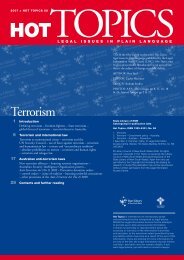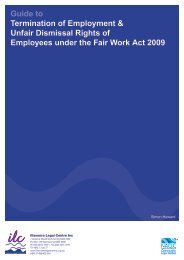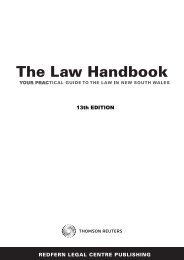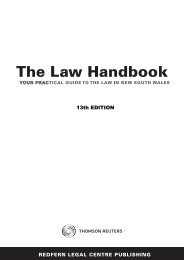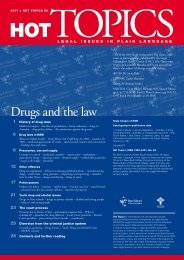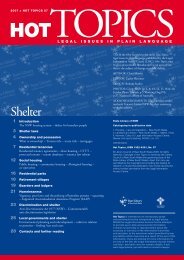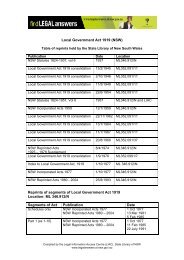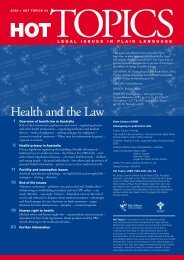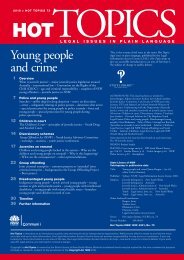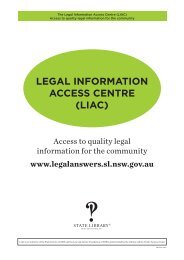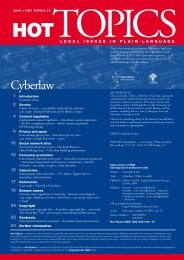Prisoners - Legal Information Access Centre - NSW Government
Prisoners - Legal Information Access Centre - NSW Government
Prisoners - Legal Information Access Centre - NSW Government
Create successful ePaper yourself
Turn your PDF publications into a flip-book with our unique Google optimized e-Paper software.
any other matter necessary to enable the inmate to<br />
understand the inmate’s rights and obligations and<br />
adapt to living in the centre.<br />
An inmate must surrender all property in their possession<br />
to an authorised officer. Any property belonging to the<br />
inmate brought to the prison by a police officer or<br />
Corrective Services Officer will be handed to the general<br />
manager. The general manager determines which items<br />
of property are suitable for the inmate to have in their<br />
possession. See ‘Property’ below for more detail on what<br />
items inmates may possess.<br />
Case management plans are made as soon as practicable<br />
after the inmate’s arrival, and cover such things as:<br />
> the prisoner’s classification;<br />
> programs in which they are to be encouraged to<br />
participate;<br />
> health services;<br />
> strategies to minimalise the impact of any disability eg<br />
in relation to participation in a work program;<br />
> strategies to minimalise the risk of self harm if that<br />
appears to be likely;<br />
> implementation of the recommendations from the<br />
Report into Aboriginal Deaths in custody where the<br />
inmate is Aboriginal;<br />
> the provision of pre-release and post-release assistance<br />
(such as how to access social services and drug and<br />
alcohol programs).<br />
prisOner clAssificATiOn<br />
Prisoner classification is important because it determines <br />
at which correctional facility an inmate is placed, which <br />
has an effect on the access they have to programs. It <br />
also determines their privileges within the system. <br />
Classification and placement are reviewed every six <br />
months.<br />
When completing the Initial Case Plan form the inmate <br />
is to have explained to him/her the factors that affect his <br />
classification, placement and management:<br />
> convicted/unconvicted;<br />
> protection/not protection;<br />
> nature of offence;<br />
> length of minimum period of custody/and sentence;<br />
> assessed risk/need factors;<br />
> previous criminal record;<br />
> previous custodial history and conduct in custody;<br />
> vacancies in centres.<br />
Where an inmate is identified as ‘public interest’, <br />
‘escapee’ or ‘serious offender’, the implication of these <br />
designations must be fully explained to the inmate, <br />
particularly progression through minimum security to <br />
external leave programs.<br />
Each male inmate is classified in one of the following<br />
categories:<br />
Category AA – inmates who represent a special risk to<br />
national security (for example, because of a perceived<br />
risk that they may engage in, or incite other persons to<br />
engage in, terrorist activities) and should at all times<br />
be confined in special facilities within a secure physical<br />
barrier that includes towers or electronic surveillance<br />
equipment.<br />
Category A1 – inmates who represent a special risk<br />
to good order and security and should at all times be<br />
confined in special facilities within a secure physical<br />
barrier that includes towers or electronic surveillance<br />
equipment.<br />
Category A2 – inmates who should at all times be<br />
confined by a secure physical barrier that includes<br />
towers, other highly secure perimeter structures or<br />
electronic surveillance equipment.<br />
Category B – inmates who should at all times be<br />
confined by a secure physical barrier.<br />
Category C1 – inmates who should be confined<br />
by a physical barrier unless in the company of a<br />
correctional officer or some other person authorised by<br />
the Commissioner.<br />
Category C2 – inmates who need not be confined by<br />
a physical barrier at all times but who need some level<br />
of supervision by a correctional officer or some other<br />
person authorised by the Commissioner.<br />
Category C3 – inmates who need not be confined by<br />
a physical barrier at all times and who need not be<br />
supervised.<br />
Female inmates have similar levels of classification from<br />
Category 5 (special risk to national security) down to<br />
Category 1 (need not be confined by a physical barrier at<br />
all times and who need not be supervised).<br />
Changes to classification can be made by the<br />
Commissioner but some changes, set out in clause 27<br />
of the Crimes (Administration of Sentences) Regulations<br />
2008, must be considered by a Review Council.<br />
sepArATiOn And segregATiOn<br />
<strong>Prisoners</strong> are divided into the following classes:<br />
> convicted inmates;<br />
> unconvicted inmates;<br />
> civil inmates.<br />
As far as practicable inmates of any class are kept<br />
separate from inmates of any other class. Within each<br />
class, the Commissioner may direct that the following<br />
inmates be kept separate from other inmates:<br />
> those inmates who have not previously been<br />
imprisoned;<br />
24<br />
HOT TOPICS 67 > <strong>Prisoners</strong>



